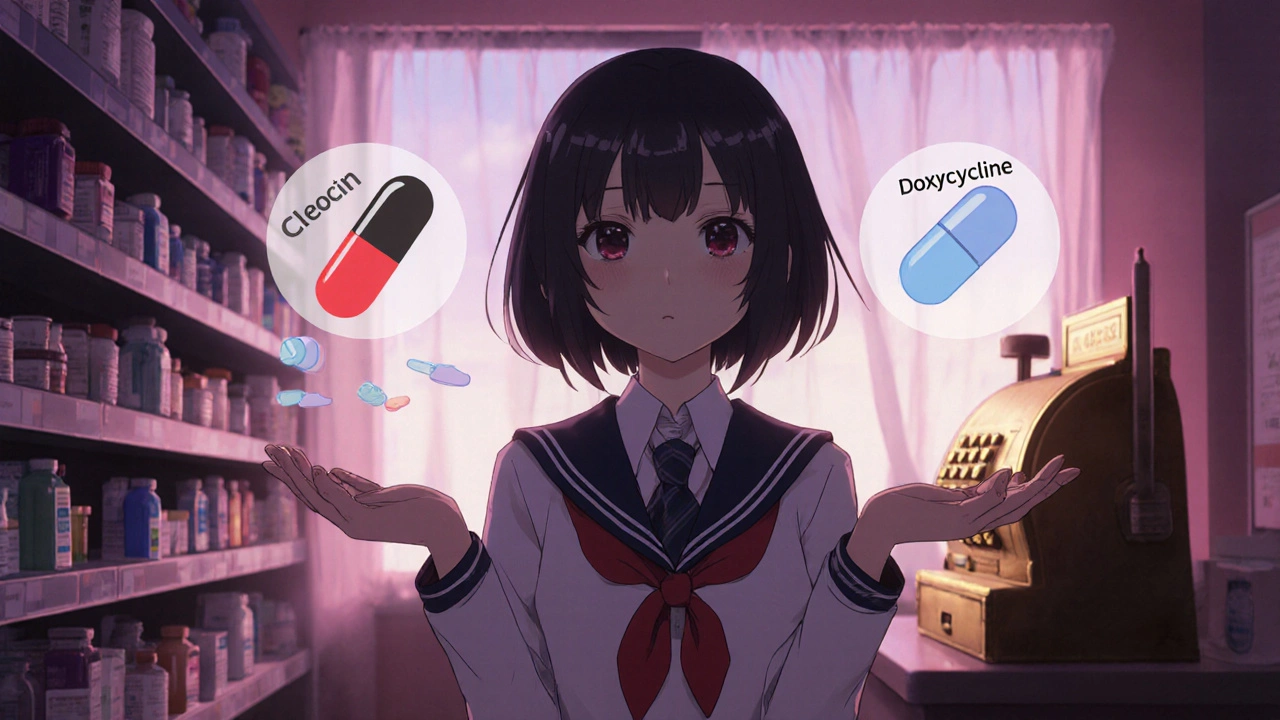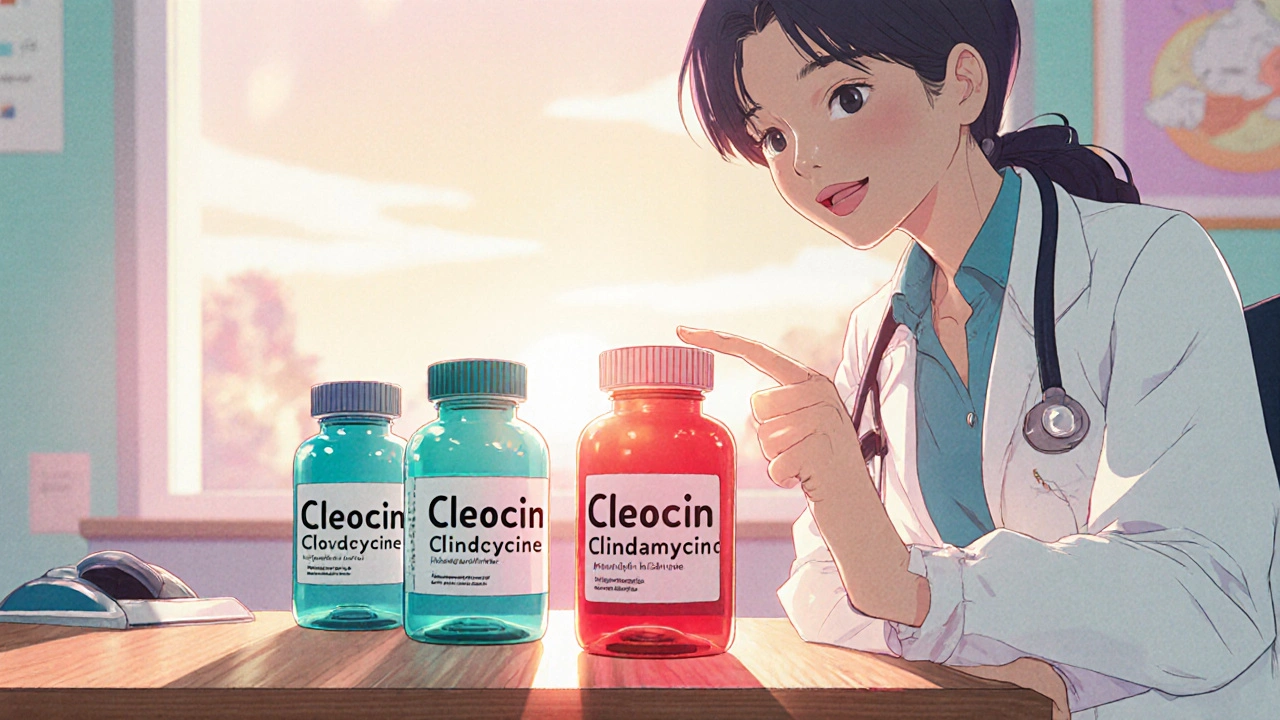Antibiotic Comparison Tool
Select Your Condition
Choose the type of infection you're treating to get tailored recommendations
Quick Takeaways
- Cleocin (clindamycin) is a lincosamide antibiotic especially strong against anaerobic bacteria and gram‑positive skin infections.
- It shines for acne, cellulitis, and bite‑wound infections, but it carries a higher risk of Clostridioides difficile colitis.
- Typical oral alternatives-doxycycline, erythromycin, minocycline, azithromycin-offer broader gram‑negative coverage, often at lower cost.
- Choose Cleocin when you need reliable activity against resistant Staphylococcus aureus (including some MRSA) or deep‑tissue anaerobes.
- For mild acne or uncomplicated skin infections, a tetracycline class drug (doxycycline or minocycline) usually provides a safer, cheaper option.
Cleocin (Clindamycin) is a prescription antibiotic belonging to the lincosamide class. It works by binding to the 50S ribosomal subunit of bacteria, halting protein synthesis and ultimately killing the micro‑organism. First approved by the FDA in 1970, Cleocin is available as oral tablets, topical gels, and injectable forms.
How Cleocin Works
Clindamycin interferes with the peptidyl transferase activity of the bacterial ribosome, a mechanism that makes it bacteriostatic against most organisms but bactericidal at higher concentrations. Its excellent tissue penetration-especially into bone and skin-explains why dermatologists love it for severe acne and why surgeons trust it for post‑operative wound prophylaxis.
Key Criteria for Comparing Antibiotics
When you line up Cleocin against other popular drugs, keep an eye on these five factors:
- Spectrum of activity: Which bacteria are covered? Gram‑positive, gram‑negative, anaerobes?
- Pharmacokinetics: Oral bioavailability, half‑life, tissue distribution.
- Typical indications: Acne, cellulitis, respiratory infections, surgical prophylaxis.
- Side‑effect profile: GI upset, photosensitivity, risk of C. difficile infection.
- Cost & insurance coverage: Price per tablet, generic availability, formulary status.
Detailed Comparison of Common Alternatives
| Antibiotic | Spectrum | Oral Bioavailability | Common Indications | Typical Dose (Adult) | Key Side Effects |
|---|---|---|---|---|---|
| Cleocin (Clindamycin) | Gram‑positive, anaerobes; limited gram‑negative | ≈ 90% | Acne, cellulitis, bite wounds, surgical prophylaxis | 150‑450 mg q6h (oral) | Diarrhea, C. difficile colitis, hepatotoxicity |
| Doxycycline | Broad gram‑positive/negative, atypicals | ≈ 95% | Acne, Lyme disease, respiratory infections | 100 mg q12h | Photosensitivity, esophageal irritation |
| Erythromycin | Gram‑positive, some gram‑negative | ≈ 70% | Skin infections, pertussis prophylaxis | 250‑500 mg q6h | GI upset, hepatic enzyme elevation |
| Minocycline | Broad gram‑positive/negative, acne‑specific | ≈ 95% | Moderate to severe acne, rheumatoid arthritis | 100 mg q12h | Vivid skin discoloration, vestibular toxicity |
| Azithromycin | Gram‑positive, gram‑negative, atypicals | ≈ 50% (but high tissue levels) | STIs, community‑acquired pneumonia, skin infections | 500 mg day 1, then 250 mg daily x4 | QT prolongation, GI upset |

When Cleocin Is the Right Choice
If your culture shows a gram‑positive anaerobe like Propionibacterium acnes or a methicillin‑resistant Staphylococcus aureus (MRSA) that’s still clindamycin‑susceptible, Cleocin often wins. Its high tissue concentrations make it a go‑to for deep skin abscesses, osteomyelitis, and severe acne unresponsive to tetracyclines.
However, avoid it as a first‑line for uncomplicated, mild acne-tetracyclines are cheaper and carry less risk of serious colitis.
Overview of Each Alternative
Doxycycline
Doxycycline’s broad spectrum and excellent oral bioavailability make it a versatile workhorse. It’s especially good for acne, tick‑borne diseases, and atypical pneumonia. The main drawback is photosensitivity; patients on outdoor jobs need sunscreen.
Erythromycin
Erythromycin is an older macrolide that still sees use when a patient can’t tolerate tetracyclines. It’s less effective against many resistant strains and often causes stomach upset, so the extended‑release form is preferred.
Minocycline
Minocycline sits in the same class as doxycycline but penetrates skin and sebum even better, which is why dermatologists love it for severe acne. Watch for rare but striking skin discoloration and dizziness.
Azithromycin
Azithromycin’s long half‑life lets you finish a course in five days, a big convenience factor. It’s useful for sexually transmitted infections and certain skin infections, yet it can affect heart rhythm in patients with existing QT issues.
Safety, Side Effects, and Resistance
All antibiotics carry a risk of fostering resistance. Cleocin’s biggest safety signal is the potential for C. difficile infection, which can be life‑threatening. In a 2023 retrospective study of 12,000 patients, clindamycin‑associated C. difficile rates were 3.5%, compared with 1.2% for doxycycline.
Most alternatives have milder GI profiles but can still trigger allergies or liver enzyme changes. Monitoring liver function tests during prolonged therapy is a good habit for any of these drugs.

Cost and Accessibility
As of October 2025, the average wholesale price for a 30‑day supply is:
- Cleocin (generic clindamycin): $45‑$55
- Doxycycline: $10‑$20
- Erythromycin: $15‑$25
- Minocycline: $12‑$22
- Azithromycin: $30‑$40 (brand Z‑Pak higher)
Insurance formularies often place clindamycin in a higher tier, so patients may face a larger copay. When cost is a deciding factor, a tetracycline class drug usually wins.
Bottom Line
If you need an antibiotic that reliably covers anaerobes and certain MRSA strains, Cleocin vs alternatives tips the scale toward Cleocin-provided you watch for C. difficile risk and are okay with the higher price. For most uncomplicated skin infections, acne, or community‑acquired respiratory bugs, a cheaper, broader‑spectrum tetracycline or macrolide will do the job with fewer serious side effects.
Frequently Asked Questions
Can I take Cleocin with doxycycline?
They’re both antibiotics, so using them together rarely adds benefit and may increase side‑effects. Only combine them if a doctor orders both for a mixed infection.
Is clindamycin safe during pregnancy?
Clindamycin is category B in the US, meaning animal studies show no risk but human data are limited. Doctors may prescribe it when the benefits outweigh potential risks.
How long does it take for Cleocin to improve acne?
Most patients notice reduced inflammation after 4‑6 weeks; full clearing can take 3‑4 months of consistent therapy.
What should I do if I develop diarrhea while on clindamycin?
Contact your provider immediately. Severe watery diarrhea could signal C. difficile infection, which requires prompt treatment.
Are there over‑the‑counter alternatives to Cleocin for mild skin infections?
Topical antiseptics like chlorhexidine or bacitracin ointment can help minor cuts, but they don’t replace a prescription antibiotic for bacterial cellulitis.


Dante Russello
October 23, 2025 AT 16:23When you’re weighing Cleocin against its cousins, the first thing to note is its impressive activity against Gram‑positive anaerobes, which makes it a solid pick for deep‑tissue infections, especially when MRSA is in the mix, but you also have to keep an eye on the C. difficile risk, because that can turn a short course into a long hospital stay, and the cost factor isn’t negligible either; many insurance plans put clindamycin in a higher tier, so patients may end up paying more out‑of‑pocket, yet the drug’s tissue penetration is hard to beat, particularly in bone and skin, and that’s why dermatologists still reach for it in severe acne cases, even though doxycycline or minocycline are often cheaper alternatives.
sara fanisha
October 29, 2025 AT 11:35Nice breakdown!
Jinny Shin
November 4, 2025 AT 06:47One cannot help but marvel at the meticulous juxtaposition of pharmacodynamics and pharmaco‑economics presented herein; the author deftly navigates the labyrinthine world of lincosamides, rendering a once‑obscure therapeutic niche into a tableau of clinical relevance, replete with nuanced discussion of anaerobic coverage and the ever‑looming specter of Clostridioides difficile. Yet, the prose occasionally drifts into a florid reverie, as if the very act of prescribing were a Shakespearean soliloquy. Nonetheless, the inclusion of granular cost brackets and insurance tier considerations elevates the piece beyond a mere academic exercise, granting it pragmatic gravitas.
deepak tanwar
November 10, 2025 AT 01:59While the lyrical flair is commendable, it obscures the stark reality that Clindamycin’s C. difficile rates remain unacceptably high; in a 2023 cohort, the incidence was nearly threefold that of doxycycline, a fact that any pragmatic clinician must foreground above poetic musings.
Abhishek Kumar
November 15, 2025 AT 21:11Seems okay.
Danielle St. Marie
November 21, 2025 AT 16:23Honestly, this guide feels like it was cobbled together from a pharmacy brochure-nothing groundbreaking, just the usual cost‑vs‑benefit spiel. 🙄💊
Peter Richmond
November 27, 2025 AT 11:35The comparison succinctly outlines efficacy, side‑effect profiles, and economic considerations, offering clinicians a clear decision‑matrix.
Bonnie Lin
December 3, 2025 AT 06:47Appreciate the concise summary; it really helps streamline the prescribing process.
Tristram Torres
December 9, 2025 AT 01:59I think clindamycin is okay for some infections.